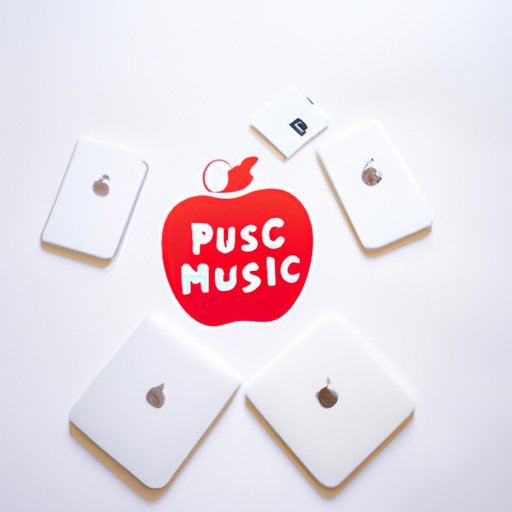
Introduction
If you’re an Apple Music subscriber, you might have considered sharing your music with your family or friends. Sharing music can be fun and can help you discover new artists and songs. However, there are some important things to consider before sharing your Apple Music with others. In this article, we’ll explore different aspects of sharing Apple Music, including how to set up a Family Sharing plan, the legality of sharing music, the pros and cons of sharing your music library, and tips and tricks for sharing playlists. We’ll also compare Apple Music to other streaming services and provide tips on how to switch your subscription.
Sharing is Caring: A Guide to Sharing Apple Music with Family and Friends
The Family Sharing plan allows up to six family members to share your Apple Music subscription. This means that each family member can have their own Apple Music account while still using the same subscription. Setting up Family Sharing is easy – simply go to your device’s settings, select Family Sharing, and then choose to share your Apple Music subscription. You can invite your family members through email or iMessage.
One of the benefits of Family Sharing is that each member has their own music library, so they can listen to their favorite songs without disturbing others. However, there are some limitations to this method. For example, you can only share your subscription with people who are part of your family group, and you cannot share your music with friends or other people outside of your family. Additionally, if one family member buys music, this purchase will be charged to the family organizer’s payment method.
If you encounter any issues with Family Sharing, such as difficulty adding family members or accessing their music, Apple’s support page provides troubleshooting tips.
Is Sharing Apple Music Legal? Here’s Everything You Need to Know
When it comes to sharing music, legality is a concern. While it is legal to listen to music on Apple Music, it is illegal to download or distribute copyrighted material without permission. Apple Music’s terms and conditions state that you can only stream music for personal, non-commercial use, and that you cannot copy or distribute music from the service.
Intellectual property laws vary from country to country, so it’s important to check the laws in your region before sharing music. Here are some tips for staying legal while sharing your Apple Music:
- Only share music with family and friends who are part of your Family Sharing plan
- Do not share your Apple Music account login details with others
- Do not distribute or sell music obtained through Apple Music
- Do not upload or share copyrighted material on social media or peer-to-peer file sharing services
The Pros and Cons of Sharing Apple Music with Your Loved Ones
Sharing your Apple Music has both benefits and drawbacks. Some of the pros include:
- Reduced cost: By sharing your subscription, you can save money on your monthly subscription fee
- Enhanced music discovery: Sharing music with others can expose you to new artists and songs you might never have discovered otherwise
However, there are some potential drawbacks to consider, such as:
- Privacy concerns: Sharing your music library means that others can see what you’ve been listening to, which may not be ideal for everyone
- Inconvenience: If you share your music library with others, you may lose control over the songs you want to listen to or even face difficulty accessing your own music library
To maximize the benefits and minimize the drawbacks of sharing music, it’s important to set some ground rules with your family and friends. You can decide on a music sharing schedule or create separate playlists for each family member, for example.
Maximizing Your Apple Music Experience: Tips and Tricks for Sharing Playlists
Creating and sharing playlists on Apple Music is a great way to enhance your music sharing experience. To create a playlist, simply go to the “New Playlist” section of the app and select the songs you want to add. You can also add descriptions and artwork to your new playlist.
If you want to collaborate on a playlist with friends or family members, you can use platforms such as SharePlaylists or Spotify’s Collaborative Playlist feature. Tapping “Add to Library” gives you the option to add a playlist to your “Library,” making it easier to access your favorites next time you listen.
Some tips for maximizing your experience with shared playlists are:
- Add songs that suit everyone’s tastes
- Spend time creating themed playlists that are relevant to the moment
- Update your playlists regularly
- Encourage everyone to add their favorite songs
From Apple Music to Spotify: How to Switch Your Subscription and Share Music with Others
If you decide to switch from Apple Music to another streaming service, such as Spotify, there are a few steps to follow. First, you need to cancel your Apple Music subscription. After this, you can sign up for a new subscription to Spotify or other streaming platform, and start sharing your music with others.
If you’ve built a complex music library on Apple Music, it can be daunting to start from scratch on a new platform. However, you can transfer your playlists using free services such as Soundiiz or Stamp, which will help you make the move as seamless as possible.
Conclusion
Sharing Apple Music with others can be a great way to discover new songs and artists, save money, and create meaningful connections with loved ones. However, it’s important to stay within the bounds of legality and to consider the potential drawbacks to sharing your music library with others. By setting ground rules and using shared playlists, you can make the most of your Apple Music subscription and share your favorite tunes with the people you care about.




